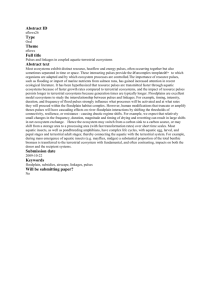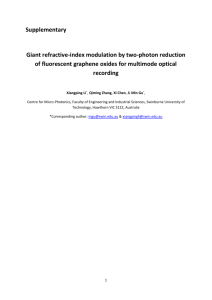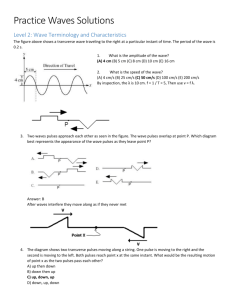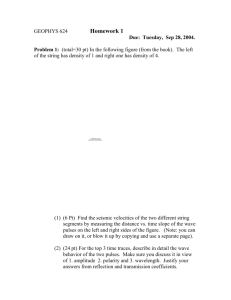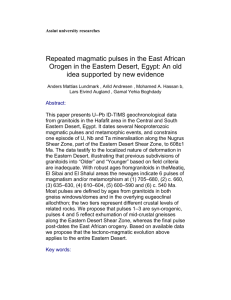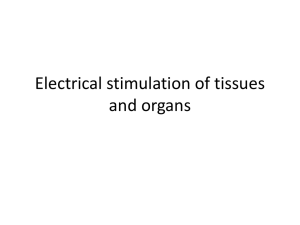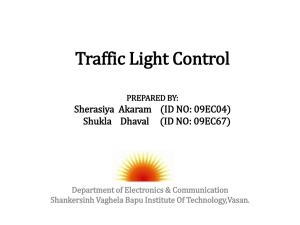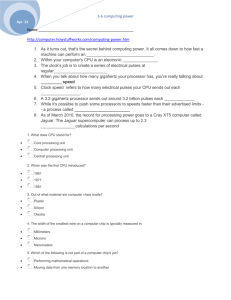processing of pulses to mineral rich dhall
advertisement
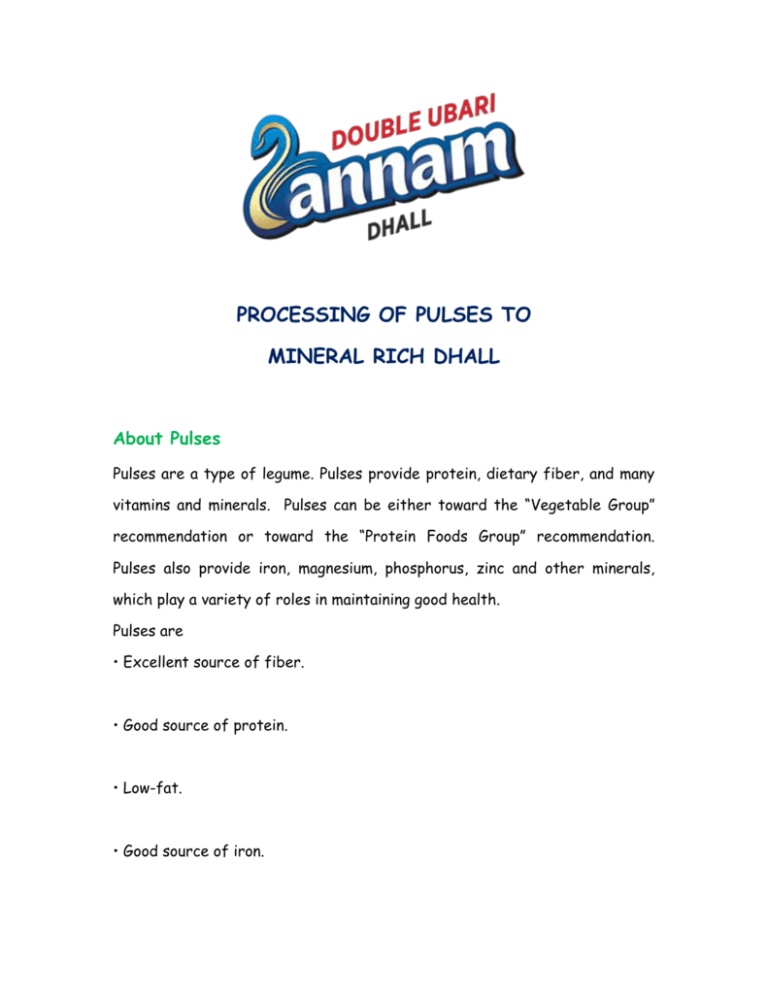
PROCESSING OF PULSES TO MINERAL RICH DHALL About Pulses Pulses are a type of legume. Pulses provide protein, dietary fiber, and many vitamins and minerals. Pulses can be either toward the “Vegetable Group” recommendation or toward the “Protein Foods Group” recommendation. Pulses also provide iron, magnesium, phosphorus, zinc and other minerals, which play a variety of roles in maintaining good health. Pulses are • Excellent source of fiber. • Good source of protein. • Low-fat. • Good source of iron. • Low glycemic index. • Gluten-free / Cholesterol-free. India's Pulse Production There are two crops in India, namely Kharif (summer crop) harvested in September and Rabi (winter crop) harvested in March/April. Major kharif pulses are green beans (moong beans), black matpe (urad), pigeon peas (arhar/tur), and cow peas (lobhia), while major rabi harvested pulses include chickpeas, green peas and lentils. A larger range of pulses is grown in India. Madhya Pradesh is the biggest pulse producing state with about 25% of the total production, Uttar Pradesh (18%), Maharashtra (15%), Rajasthan (14%),Karnataka (5%), Andhra Pradesh (5%), and Bihar (5%). India's Pulse Consumption Pulses are an important source of protein in the Indian diet. Due to stagnant production of pulses, rising population and limited imports, the per capita availability of pulses has come down to 29.1 grams per day in 2001, as compared with Pulses acreage is down from145.86 hectare to 144.49 hectare for this year . Almost each household in India use pulses. Although, particular varieties of pulses are preferred in different parts of the country, food habits are easily changed according to availability of pulses. Pulse Variety mostly used in the northern, central and southern India is Pigeon Peas (Arhar) - Popular in northern, central and southern India used to make Dhall sambar as side dish with meals. Black Matpe (Urad) - Liked throughout the country. In the north it is used for making PAPADS and in the south it is used to make PAPPADAMS as side dish with meals. In southern India it is a major ingredient for making several dishes, including Idli , Vada and dosa . Mung Beans (green beans) - Consumed mostly in north Indian states where it is a preferred dish with boiled white rice. Marketing: There are wholesale-specialized pulses markets throughout India, which route domestic and imported pulses to retailers. As each seller operates independently, the wholesale trade is generally fragmented. Out of the total DHALL (processed pulses) market potential 10% is only covered by the major brands and rest 90% are the loose packet sellers, which is an unorganized segment. There are several layers in the marketing chain between the farmer processor and consumer, Retail Sales of Pulses in the Indian Retail Market in Tones 2006 - 15,064.20, 2007-17,422.30, 2008 - 18,120.40, 2009-19,670.40, 2010 21,130.10. In southern Asia, especially India where the vegetarian’s population is large, the key driver to increased pulse consumption is improving incomes and higher dietary expectations. To maintain the supplydemand deficit of pulses in the country lower, the government of India increased the productivity of the commodities in the country and in the past four year, the production of pulses rose by 14.4 million tons to 18.2 million tons in 2010-11 from 14.06 million tons 2006-07. MARKET POTENTIAL The all India per capita consumption of pulses is about 2.8 kg per year. Government policy on pulses Eventhough India is the world’s largest pulses producer, India has been importing 3-4 million tons (MT)of pulses every year to meet its domestic demand. However, during the last decade, growth in pulses production has increased significantly. India achieved a record output in pulses production at 18.1 MT in 2010-11 with an all-time high production achieved in chickpea (8.25 MT), moong (1.82MT) and urad (1.74 MT). Governmnet of INDIA increases the MSP of pulses in order to attract the farmers to go in for pulses production than any other cash on crops during the season. Annual total consumption of all types of pulses countrywide is estimated at 17 million tonnes. As pulses are consumed almost daily by the economically vulnerable sections of the Indian society more than the middle classes and the affluent, the Indian Government controls the price situation in the volatile wholesale/retail markets and implementing corrective measures to ensure availability at affordable prices by increasing the local availability through large scale imports through Indian Government trading organizations such as the NAFED, MMTC, STC and PEC. Government is watching the stock hoarding traders, who creates the artificial demands also with punishments. Imports: The import of pulses is allowed and comes in the OGL category without any restrictions. TUR(Pigeon Pea),URAD(Black Matpe) are imported mostly from Myanmar and Tanzania & Malawi. Moong(Green Mung) is imported from Australia. Exports: Since 2007 there is a ban on exporting PULSES and in the recent past government permitted the 100EOUs to export the pulses from INDIA. In order to maintain the supply- demand deficit of pulses in the country lower. Recently government allowed to export pulses against the imports through advanced license scheme. DAL MILL Introduction: Pulses are basically grain legumes. They occupy an important place in human nutrition due to their high protein content than cereal grains. In Indian dietary regime it occupies an important place. Since majority of Indians are vegetarians, they depend largely on grain legumes (pulses) for their dietary protein. Pulses contribute a major portion of lysine in the vegetarian diet. They are also a fairly good source of vitamins like thiamine, niacine, riboflavin and much needed iron. DHALL MILLING Process: In India most of the pulses are consumed in dehusked and split form. Thus processing of pulses assumes a lot of importance. Pulses processing industry helps in processing the raw grain legumes/ pulses into edible form. The process involves different stages like cleaning, milling, dehusking, oil/water treatment , polishing, grading and packing, Dhall as a Food In Indian cooking, dal is the main accompaniment that can be served with any type of rice it provides the requisite proteins for a balanced meal. Toor dal or Tur dal is staple food in Indian cuisine. It is the main protein compliment for vegetarian diet when paired with a starchy food like rice and is a dish that is prepared everyday in most of the Indian homes. Nutrition factors Dhall is a staple vegetarian food in every man’s diet. The daily per capita consumption is around 20 – 30 gms. It’s a rich source of protein and easily assimilated in our body. Being consumed by one and all it forms an important vehicle for promoting better Nutrition among the Human Populations. Dhall is the only product, which is not geography specific or customer specific. Every day from children to old people a minimum of 25 grams consumed per day in various forms. VASMO FOODS CO PRIVATE LIMITED is the only company in India to have in-house R&D exclusively on Dhall products Over 5 years of R&D VASMO group has come out First time in India with Mineral enriched Dhall – Tested by ICMR Malnutrition The most vulnerable are the children of the urban slums, especially new born babies and infants. Their health and development is entirely dependent upon their mothers’ ability to breastfeed, the ability of mothers or caretakers to provide nutritious meals, maternal nutrition is fundamental to reducing the chances of child malnutrition. 47% of children in India under the age of five are stunted (a ratio of height to age: too short for age), 16% are wasted (too thin for their height) and 35% are underweight. On top of this, child malnutrition plays about a 50% role in the cause of child mortality. A child’s full potential is therefore severely reduced by malnourishment. The main reason why women and children are not being fed properly because of the non affordability of nutrient rich foods and supplements, secondly they don’t give priority for nutritious food. Due to the deficiency of IRON the anemia happens and create complications. First of it’s kind in INDIA DOUBLE UBARI ANNAM DHALL provides the improved nutrition through enhanced nutrient availability. About the Mineral Rich Dhall The per capita consumption of red gram (tur dhal), black gram (orid dhal) and green gram (mung dhal) each is around 25 to 30 grams per day in the State of Tamil Nadu. It is a staple in everyman’s diet. The current sale of these pulses together is 95475MT per month (approx). Considering the high per capita consumption and its richness in protein, laboratory studies were carried out in detail to explore the possibility if the protein could aid the availability of micronutrient minerals like iron, calcium, magnesium, phosphorus and zinc. Four major concerns formed the basis of enrichment. The first pertained to the retention of the minerals in the dhal when being washed prior to cooking; the second on the quantum of enrichment which provided 20 to 25% of the daily requirement of the minerals; increased bioavailability of the minerals; and safety of the dhal for purposes of consumption as envisaged by toxicological studies. Nutritive value of pulses(without enrichment) (Values are for 100 grams of the dhal) Description Urad dhal Tur dhal Mung dhal Moisture (gms) 10.9 13.4 10.1 Protein (gms) 24.0 22.3 24.5 Fat (gms) 1.4 1.7 1.2 Fibre (gms) 0.9 1.5 0.8 59.6 57.6 59.9 Energy (k cal) 347 335 348 Calcium (mgms) 154 73 75 Phosphorus (mgms) 385 304 405 Magnesium (mgms) 130 90 122 Zinc (mgms) 3.0 0.9 2.8 Iron (mgms0 3.8 2.7 3.9 Carotenes (mcg) 38 132 49 Thiamine (mgms) 0.42 0.45 0.47 Riboflavin (mgms) 0.20 0.19 0.21 Niacin (mgms) 2.0 2.9 2.4 Folic acid (mcg) 132 103 140 0 0 0 206 183 0 Carbohydrates (gms) Vitamin C (mgms) Choline (mgms) MINERAL ENRICHED DHALL NUTRIENT VALUE COMPARISON Normal Dhall Double UbariAnnam Dhall (Mineral (Mineral Enriched) Toor Dhall Iron 4mg 7 – 12 mg Moong Iron 6 mg 10 – 20 mg Calcium < 80 mg 120 - 200 mg Magnesium < 50 mg 100 – 180 mg Zinc < 1 mg 1.5 – 3 mg Phosphorus < 150 mg 250 – 350 mg Dhall Orid Dhall The benefits of enriched minerals in dhall Conclusion: By eating the mineral enriched DOUBLE UBARI ANNAM Dhall, the only mineral enriched dhall in INDIA, people are benefited to get the balanced diet and 15%-20% of the daily requirement of the RDA is available and the rest can be getting from other food intakes. Considering the societal benefit the mineral enriched dhalls are being sold at par the normal dhall price. By De.Srenivasan Head-Operations VASMO FOODS CO PRIVATE LIMITED CHENNAI
